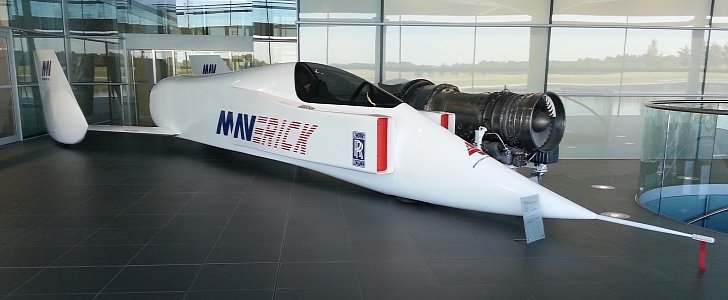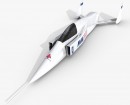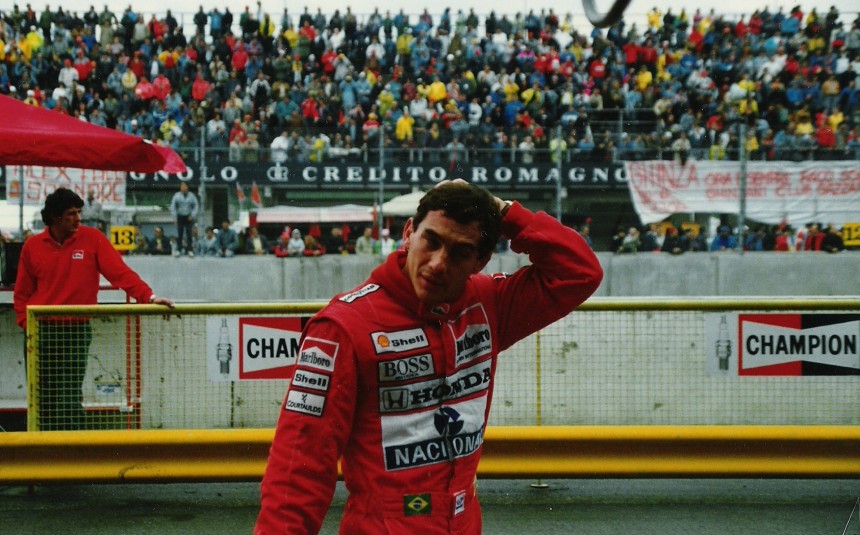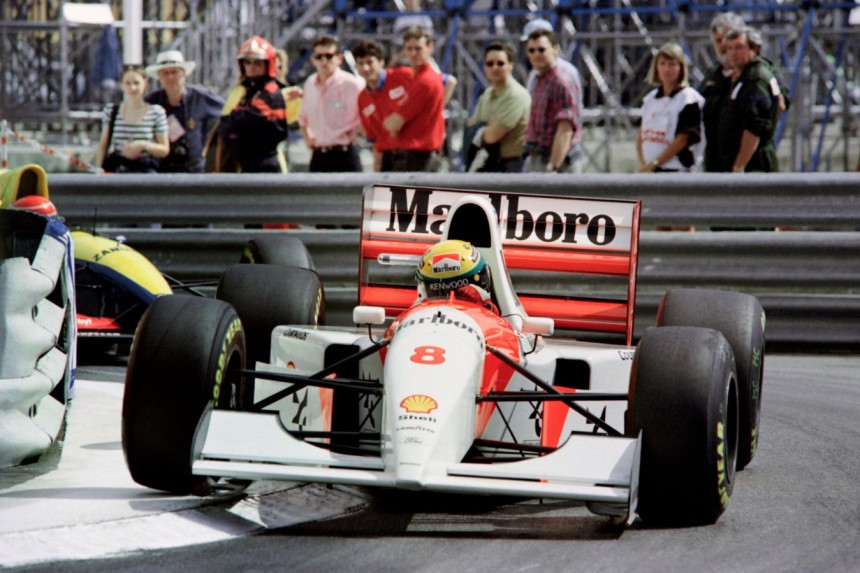“For of all sad words of tongue or pen, The saddest are these: 'It might have been!'” - This line is from a poem by John Greenleaf Whittier and has been quoted probably too many times, but I found it fitting for this long-forgotten record attempt.
Did I say "attempt"? It was more like the attempt of an attempt in the end, but it all started with McLaren throwing a lot of money and resources in the early 1990s to start a brand new project for them.
In short, that project translated into breaking the all-time land speed record in a specially designed jet-powered vehicle, with early rumors putting none other than Ayrton Senna as the driver of the thingamajig. Spoiler alert, the plan never went fully ahead.
As you all know, Ayrton Senna succumbed to a Formula 1 accident in 1994, at Imola, when he was no longer part of McLaren, while the jet-powered car never got past the mockup stage.
It had all started around 1991, when Ron Dennis, McLaren's head honcho, was riding on the waves of one Formula 1 success after another. Alain Prost had left the team but Ayrton Senna was still the man to beat and he was McLaren's protégé.
The land speed record (LSR) story had started to pick up pace in 1993, and it oddly involved Richard Noble, who had held the record for ten years at the time with the Thrust2 and was secretly working on the Thrust SSC, which currently holds the record for the fastest land vehicle.
As it happens, someone at McLaren got in touch with Noble, asking him if he had any footage of land speed record attempts, but without telling him the reason. Other acquaintances around Richard had received similar inquiries, so the beans were obviously spilled – McLaren was working on beating his record with a car of its own.
A few months later, in mid-December 1993, McLaren was organizing a mysterious press conference at its headquarters in Woking, officially announcing that its engineers had been developing a jet-powered vehicle to break the land speed record for the last couple of years.
Sadly, no cameras were allowed on the premises, but McLaren also showed a mockup of the vehicle, tentatively named Maverick. The Brits not only wanted to go after Richard Noble's record from 1983, but they wanted to do it in style, by breaking the sound barrier as well.
The actual vehicle was to be further developed and built by a newly formed skunkworks team called McLaren Advanced Vehicles (the MAV in Maverick) and millions upon millions would be poured into the project to ensure its success.
Not officially confirmed, but the man who was initially envisioned to the task of actually driving the LSR car was none other than McLaren's sweetheart, Ayrton Senna. That said, Senna had already announced his departure from the Formula 1 team before that mysterious press conference took place, so we'll never know if Ron Dennis was still pursuing the record with the Brazilian on board or not.
The vehicle itself was vastly different than Richard Noble's Thrust SSC, who would eventually claim the record in 1997. About three times lighter, two times smaller and using a single-engine instead of two, the Maverick was pretty much an extension of McLaren's Formula 1 know-how, going for the technology road instead of brute force.
Carbon fiber and various light composites such as Kevlar instead of aluminum and steel meant that the car was over three times lighter than the Thrust SSC, with the speed record attempt depending more on aerodynamics and efficiency than on sheer power like the former.
Unlike the Thrust SSC or any other LSR vehicle for that matter, the McLaren was to be fitted with an ejectable seat derived from those on fighter jets.
In fact, it would have been the first and only ground vehicle to feature such a contraption this side of a goofy spy movie. Apparently, the driver would be automatically ejected from the Maverick if the onboard computers would sense that the car has tilted to an angle that's “inconsistent with the wheels being on the ground.” as Ron Dennis would so eloquently put it.
There was no word of the driver's seat being fitted with a parachute, but it's probably safe to assume that it was. Ron Dennis himself is said to have overlooked most of the details surrounding the project, so nothing was left to chance.
Almost 42 feet long and about 17 feet wide, the vehicle had a similar footprint as other single-engined LSR cars, while the design reminded more of a wing-less fighter jet. Speaking of which, the car was to be powered by the Turbo-Union RB199 engine from a Tornado jet fighter, which delivers around 38,000 horsepower.
That would have made it not only the fastest but by far the most powerful McLaren vehicle in history. Amusingly, all that power was almost a third of what the Thrust SSC had from its two Rolls-Royce Spey engines, which were rated at a combined 110,000 horsepower.
Another Formula 1 feature that was to be included in the Maverick was a computerized active suspension, which was supposed to allow the car to smoothly transition from sub- to over Mach 1 speeds without too much hassle. Ironically, active suspensions have been banned from F1 for quite some time.
Initially, the land speed record attempt was supposed to take place in the summer of 1998, but for one reason or another, the project was shelved before it progressed too much over the prototype stage.
Some voices say that Ayrton Senna's tragic death at Imola was one of the reasons for Ron Dennis to pull the plug on the project. That is unlikely considering that he was no longer driving for McLaren when he died, and the Maverick mockup was unveiled to the public when his switch to Williams had already been announced.
A more plausible reason would be strangely related to Ron Dennis' patriotism. In short, after the British-developed Thrust SSC managed to demolish the Land Speed Record in 1997 at the hands of RAF pilot Andy Green, he was apparently quoted as saying that McLaren's corporate image would suffer if it would compete against another team from the Albion.
That makes sense, but the most rational explanation for the project's death would probably be related to resources. McLaren's budget at the time was mostly directed toward Formula 1, and Ron Dennis would have been too proud to search for outside sponsorship for such a long-term project. Either way, Thrust SSC's 1997 success played its part in pulling the plug, for better or for worse.
McLaren of today is very different from the one in the 1990s, but a similar endeavor would probably still make sense if the planets align the right way, especially in F1. so watch this space if the Bloodhound LSR fails in its quest to become the fastest land vehicle.
In short, that project translated into breaking the all-time land speed record in a specially designed jet-powered vehicle, with early rumors putting none other than Ayrton Senna as the driver of the thingamajig. Spoiler alert, the plan never went fully ahead.
As you all know, Ayrton Senna succumbed to a Formula 1 accident in 1994, at Imola, when he was no longer part of McLaren, while the jet-powered car never got past the mockup stage.
It had all started around 1991, when Ron Dennis, McLaren's head honcho, was riding on the waves of one Formula 1 success after another. Alain Prost had left the team but Ayrton Senna was still the man to beat and he was McLaren's protégé.
As it happens, someone at McLaren got in touch with Noble, asking him if he had any footage of land speed record attempts, but without telling him the reason. Other acquaintances around Richard had received similar inquiries, so the beans were obviously spilled – McLaren was working on beating his record with a car of its own.
A few months later, in mid-December 1993, McLaren was organizing a mysterious press conference at its headquarters in Woking, officially announcing that its engineers had been developing a jet-powered vehicle to break the land speed record for the last couple of years.
Sadly, no cameras were allowed on the premises, but McLaren also showed a mockup of the vehicle, tentatively named Maverick. The Brits not only wanted to go after Richard Noble's record from 1983, but they wanted to do it in style, by breaking the sound barrier as well.
The actual vehicle was to be further developed and built by a newly formed skunkworks team called McLaren Advanced Vehicles (the MAV in Maverick) and millions upon millions would be poured into the project to ensure its success.
The vehicle itself was vastly different than Richard Noble's Thrust SSC, who would eventually claim the record in 1997. About three times lighter, two times smaller and using a single-engine instead of two, the Maverick was pretty much an extension of McLaren's Formula 1 know-how, going for the technology road instead of brute force.
Carbon fiber and various light composites such as Kevlar instead of aluminum and steel meant that the car was over three times lighter than the Thrust SSC, with the speed record attempt depending more on aerodynamics and efficiency than on sheer power like the former.
Unlike the Thrust SSC or any other LSR vehicle for that matter, the McLaren was to be fitted with an ejectable seat derived from those on fighter jets.
In fact, it would have been the first and only ground vehicle to feature such a contraption this side of a goofy spy movie. Apparently, the driver would be automatically ejected from the Maverick if the onboard computers would sense that the car has tilted to an angle that's “inconsistent with the wheels being on the ground.” as Ron Dennis would so eloquently put it.
There was no word of the driver's seat being fitted with a parachute, but it's probably safe to assume that it was. Ron Dennis himself is said to have overlooked most of the details surrounding the project, so nothing was left to chance.
Almost 42 feet long and about 17 feet wide, the vehicle had a similar footprint as other single-engined LSR cars, while the design reminded more of a wing-less fighter jet. Speaking of which, the car was to be powered by the Turbo-Union RB199 engine from a Tornado jet fighter, which delivers around 38,000 horsepower.
That would have made it not only the fastest but by far the most powerful McLaren vehicle in history. Amusingly, all that power was almost a third of what the Thrust SSC had from its two Rolls-Royce Spey engines, which were rated at a combined 110,000 horsepower.
Initially, the land speed record attempt was supposed to take place in the summer of 1998, but for one reason or another, the project was shelved before it progressed too much over the prototype stage.
Some voices say that Ayrton Senna's tragic death at Imola was one of the reasons for Ron Dennis to pull the plug on the project. That is unlikely considering that he was no longer driving for McLaren when he died, and the Maverick mockup was unveiled to the public when his switch to Williams had already been announced.
A more plausible reason would be strangely related to Ron Dennis' patriotism. In short, after the British-developed Thrust SSC managed to demolish the Land Speed Record in 1997 at the hands of RAF pilot Andy Green, he was apparently quoted as saying that McLaren's corporate image would suffer if it would compete against another team from the Albion.
That makes sense, but the most rational explanation for the project's death would probably be related to resources. McLaren's budget at the time was mostly directed toward Formula 1, and Ron Dennis would have been too proud to search for outside sponsorship for such a long-term project. Either way, Thrust SSC's 1997 success played its part in pulling the plug, for better or for worse.
McLaren of today is very different from the one in the 1990s, but a similar endeavor would probably still make sense if the planets align the right way, especially in F1. so watch this space if the Bloodhound LSR fails in its quest to become the fastest land vehicle.








